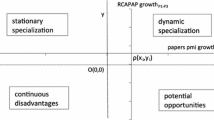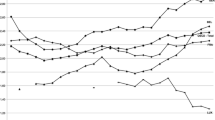Abstract
We distinguish between an internal differentiation of science and technology that focuses on instrumentalities and an external differentiation in terms of the relations of the knowledge production process to other social domains, notably governance and industry. The external contexts bring into play indicators and statistical techniques other than publications, patents, and citations. Using regression analysis, for example, one can examine the importance of knowledge and knowledge spill-over for economic development. The relations can be expected to vary among nations and regions. The field-specificity of changes is emphasized as a major driver of the research agenda. In a knowledge-based economy, institutional arrangements can be considered as support structures for cognitive developments.
Similar content being viewed by others
References
Andersen, E. S. (1994), Evolutionary Economics: Post-Schumpeterian Contributions. London: Pinter.
Aoki, M. (2001), Towards a Comparative Institutional Analysis. Cambridge, MA: MIT Press.
Bathelt, H. (2003), Growth regimes in spatial perspective 1: Innovation, institutions and social systems. Progress in Human Geography, 27(6): 789–804.
Braczyk, H.-J., P. Cooke, M. Heidenreich (Eds) (1998), Regional Innovation Systems. London/ Bristol PA: University College London Press.
Braun, T. (2005), Handbook of quantitative science and technology research. The use of publication and patent statistics in studies of S&T systems. Scientometrics, 63(1): 185–188.
Braverman, H. (1974), Labor and Monopoly Capital. The Degradation of Work in the Twentieth Century. New York/London: Monthly Review Press.
Carter, A. P. (1996), Measuring the performance of a knowledge-based economy. In: D. Foray, B. A. Lundvall (Eds), Employment and Growth in the Knowledge-Based Economy, Paris: OECD, pp. 61–68.
Casson, M. (1997), Information and Organization: A New Perspective on the Theory of the Firm. Oxford: Clarendon Press.
Clark, B. R. (1998), Creating Entrepreneurial Universities: Organization Pathways of Transformation. Guildford, UK: Pergamon.
Cooke, P., L. Leydesdorff (2006), Regional development in the knowledge-based economy: The construction of advantages. Journal of Technology Transfer, 31(1): 5–15.
Cowan, R., D. Foray (1997), The economics of codification and the diffusion of knowledge. Industrial and Corporate Change, 6: 595–622.
De Bandt, J., M. Humbert (1985), La mésodynamique industrielle. Cahiers du CERNEA, Nanterre.
Dits, H., G. Berkhout (1999), Towards a policy framework for the use of knowledge in innovation systems. Journal of Technology Transfer, 14: 211–221.
Etzkowitz, H. (2002), MIT and the Rise of Entrepreneurial Science. London: Routledge.
Etzkowitz, H., L. Leydesdorff (2000), The dynamics of innovation: From national systems and ‘Mode 2’ to a Triple Helix of university-industry-government relations. Research Policy, 29(2): 109–123.
European Commission (2000), Towards a European research area. Brussels, 18 January 2000; at http://europa.eu.int/comm/research/era/pdf/com2000-6-en.pdf
Foray, D. (2004), The Economics of Knowledge. Cambridge, MA/London: MIT Press.
Foray, D., B.-A. Lundvall (1996), The knowledge-based economy: From the economics of knowledge to the learning economy. In: Employment and Growth in the Knowledge-Based Economy, Paris: OECD, pp. 11–32.
Freeman, C. (1982), The Economics of Industrial Innovation. Harmondsworth: Penguin.
Freeman, C. (1988), Japan, a new system of innovation. In: G. Dosi, C. Freeman, R. R. Nelson, G. Silverberg, L. Soete (Eds), Technical Change and Economic Theory, London: Pinter, pp. 31–54.
Freeman, C., C. Perez (1988), Structural crises of adjustment, business cycles and investment behaviour. In: G. Dosi, C. Freeman, R. Nelson, G. Silverberg, L. Soete (Eds), Technical Change and Economic Theory, London: Pinter, pp. 38–66.
Galbraith, J. K. (1967), The New Industrial State. Penguin: Harmondsworth.
Gibbons, M., C. Limoges, H. Nowotny, S. Schwartzman, P. Scott, M. Trow (1994), The New Production of Knowledge: The Dynamics of Science and Research in Contemporary Societies. London: Sage.
Glenisson, P., W. Glänzel, F. Janssens, B. De Moor (2005), Combining full text and bibliometric information in mapping scientific disciplines. Information Processing and Management, 41(6): 1548–1572.
Granstrand, O. (1999), The Economics and Management of Intellectual Property: Towards Intellectual Capitalism. Cheltenham, UK: Edward Elgar.
Jaffe, A. B., M. Trajtenberg (2002), Patents, Citations, and Innovations: A Window on the Knowledge Economy. Cambridge, MA/London: MIT Press.
Joerges, B., T. Shinn (Eds) (2001), Instrumentation between Science, State and Industry. Dordrecht, etc: Kluwer.
Keynes, J. M. (1936), General Theory of Employment, Interest and Money. New York: Harcourt Brace.
Kooiman, J. (Ed.) (1993), Modern Governance: New Government-Society Interactions. London: Sage.
Larédo, P. (2003), Six major challenges facing public intervention in higher education, science, technology and innovation. Science and Public Policy, 30(1): 4–12.
Leydesdorff, L. (1990), The scientometrics challenge to science studies. EASST Newsletter, 9: 5–11.
Leydesdorff, L. (1995), The Challenge of Scientometrics: The Development, Measurement, and Self-Organization of Scientific Communications. Leiden: DSWO Press, Leiden University; at http://www.universal-publishers.com/book.php?method=ISBN&book=1581126816
Leydesdorff, L. (1996), The Knowledge-Based Economy: Modeled, Measured, Simulated. Universal Publishers, Boca Rota, Fl.
Leydesdorff, L. (1997), The new communication regime of university-industry-government relations. In: H. Etzkowitz, L. Leydesdorff (Eds), Universities and the Global Knowledge Economy, London and Washington: Pinter, pp. 106–117.
Leydesdorff, L. (1998), Theories of citation? Scientometrics, 43(1): 5–25.
Leydesdorff, L. (2004), The university-industry knowledge relationship: Analyzing patents and the science base of technologies. Journal of the American Society for Information Science & Technology, 55(11): 991–1001.
Leydesdorff, L. (2005), The evaluation of research and the evolution of science indicators. Current Science, 89(9): 1510–1517.
Leydesdorff, L., M. Meyer (2003), The Triple Helix of university-industry-government relations: Introduction to the topical issue. Scientometrics, 58(2): 191–203.
Leydesdorff, L., I. Hellsten (2005), Metaphors and diaphors in science communication: Mapping the case of ’stem-cell research,’ Science Communication, 27(1): 64–99.
Leydesdorff, L., W. Dolfsma, G. Van der Panne (2006), Measuring the knowledge base of an economy in terms of Triple-Helix relations among ‘Technology, Organization, and Territory’. Research Policy, 35(2): 181–199.
Leydesdorff, L., M. Meyer (2006), Triple Helix indicators of knowledge-based innovation systems: Introduction to the Special Issue. Research Policy, 35(10): 1551–1449.
Luhmann, N. (1989), Die Wirtschaft der Gesellschaft. Frankfurt a.M.: Suhrkamp.
Luhmann, N. (1990), Die Wissenschaft der Gesellschaft. Frankfurt a.M.: Suhrkamp.
Lundvall, B.-Å. (1988), Innovation as an interactive process: From user-producer interaction to the national system of innovation. In: G. Dosi, C. Freeman, R. Nelson, G. Silverberg, L. Soete (Eds), Technical Change and Economic Theory, London: Pinter, pp. 349–369.
Lundvall, B.-Å. (Ed.) (1992), National Systems of Innovation. London: Pinter.
Lundvall, B.-Å., S. Borras (1997), The Globalising Learning Economy: Implication for Innovation Policy. Luxembourg: European Commission.
Marz, L., M. Dierkes (1994), Leitbildpragung und Leitbildgestaltung, In: G. Bechmann, T. Petermann (Eds), Interdisziplinäre Technikforschung: Genese, Folgen, Diskurs, Campus, Frankfurt a.M, pp. 35–71.
McKelvey, M. D. (1996), Evolutionary Innovations: The Business of Biotechnology. Oxford: Oxford University Press.
Meyer, M., M. Du Plessis, T. Tukeva, J. T. Utecht (2005), Inventive output of academic research: A comparison of two science systems. Scientometrics, 63(1): 145–161.
Nelson, R. R. (Ed.) (1993), National Innovation Systems: A Comparative Analysis. New York: Oxford University Press.
Nelson, R. R., S. G. Winter (1982), An Evolutionary Theory of Economic Change. Cambridge, MA: Belknap Press of Harvard University Press.
Noble, D. (1977), America by Design. New York: Knopf.
Nowotny, H., P. Scott, M. Gibbons (2001), Re-Thinking Science: Knowledge and the Public in an Age of Uncertainty. Cambridge, etc: Polity.
OECD/Eurostat (1997), Proposed Guidelines for Collecting and Interpreting Innovation Data, “Oslo Manual.” Paris: OECD.
Pavitt, K. (1984), Sectoral patterns of technical change: Towards a theory and a taxonomy. Research Policy, 13: 343–373.
Persson, O. (1994), The intellectual base and research fronts of JASIS 1986–1990. Journal of the American Society for Information Science, 45(1): 31–38.
Price, D. de Solla (1984), The science/technology relationship, the craft of experimental science, and policy for the improvement of high technology innovation. Research Policy, 13: 3–20.
Riba-Vilanova, M., L. Leydesdorff (2001), Why Catalonia cannot be considered as a regional innovation system. Scientometrics, 50(2): 215–240.
Rothwell, R., W. Zegveld (1981), Industrial Innovation and Public Policy. London: Pinter.
Schumpeter, J. (1912), The Theory of Economic Development. Oxford: Oxford University Press.
Schumpeter, J. (1943), Socialism, Capitalism and Democracy. London: Allen & Unwin.
Shinn, T. (2002), The Triple Helix and new production of knowledge: Prepackaged thinking on science and technology. Social Studies of Science, 32(4): 599–614.
Shinn, T., E. Lamy (2006), Paths of commercial knowledge: Forms and consequences of university-enterprise synergy in scientist-sponsored firms. Research Policy, 35(10): 1465–1476.
Skolnikoff, E. B. (1993), The Elusive Transformation: Science, Technology and the Evolution of International Politics. Princeton, NJ: Princeton University Press.
Van den Belt, H., A. Rip (1987), The Nelson-Winter-Dosi Model and synthetic dye chemistry. In: W. E. Bijker, T. P. Hughes, T. J. Pinch (Eds), The Social Construction of Technological Systems. New Directions in the Sociology and History of Technology, Cambridge MA: MIT Press, pp. 135–158.
Verspagen, B. (2006), University research, intellectual property rights and european innovation systems Working paper 06.05 of the Eindhoven Centre for Innovation Studies ECIS, available at http://fp.tm.tue.nl/ecis/Working%20Papers/Eciswp144.pdf.
Whitley, R. D. (1984), The Intellectual and Social Organization of the Sciences. Oxford: Oxford University Press.
Williamson, O. (1985), The Economic Institutions of Capitalism. New York: Free Press.
Author information
Authors and Affiliations
Corresponding author
Rights and permissions
About this article
Cite this article
Leydesdorff, L., Meyer, M. The scientometrics of a Triple Helix of university-industry-government relations (Introduction to the topical issue). Scientometrics 70, 207–222 (2007). https://doi.org/10.1007/s11192-007-0200-y
Received:
Issue Date:
DOI: https://doi.org/10.1007/s11192-007-0200-y




